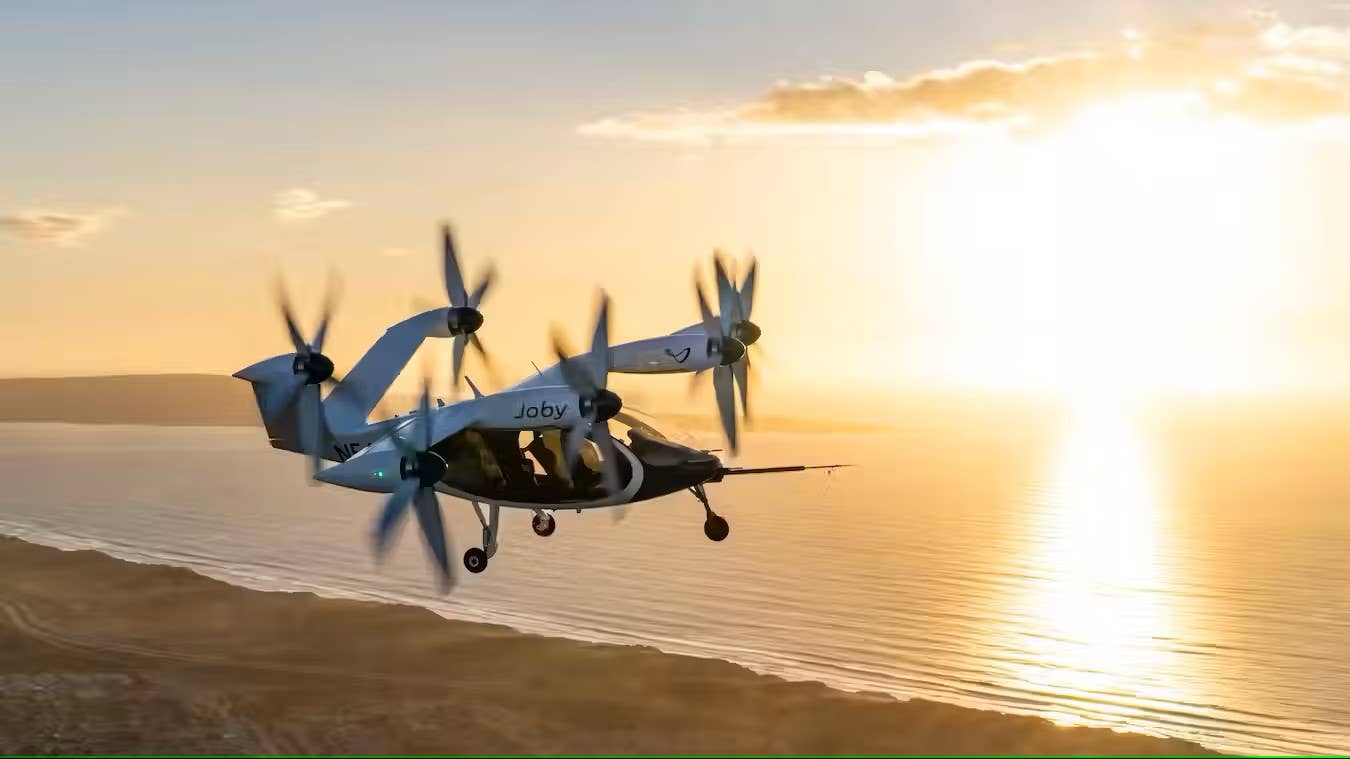NTSB Cites Blade Separation in Electric Aircraft Accident
The National Transportation Safety Board is citing blade failure as the cause of the crash of a remotely piloted Joby Aviation electric aircraft in 2022.

Joby Aviation is developing an electric air taxi to carry a pilot plus as many as four passengers. A preproduction prototype suffered an accident during flight testing on February 16, 2022. [Courtesy: Joby Aviation]
Co-authored with Jack Daleo.
The National Transportation Safety Board is citing blade failure as the cause of the crash of a remotely piloted Joby Aviation electric aircraft in 2022. According to the NTSB's final report, the accident, which took place on February 16, happened during the second test flight of the day for the JAS4-2, the first of two second-generation preproduction prototypes.
Since JAS4-2, an uncrewed experimental aircraft designated N542AJ, was involved in flight testing, it was being observed from a manned chase airplane.
The flight began about 09:42 PST with a normal vertical takeoff, transition to wing-borne flight, and climb up to 11,000 feet msl. The remote pilot in command (PIC) put the aircraft into a descent, with the unit reaching a maximum dive speed of 181 knots. As the aircraft passed through 8,900 feet the propeller from propulsion station 3 located on the right inboard wing experienced oscillations in rpm and motor vibrations.
Per the NTSB report, "after reaching a maximum dive speed of 181 knots indicated airspeed (kias) at an altitude of approximately 8,900 feet, a propeller blade on propulsion station 3 experienced a bending failure near the root of the blade which culminated in the release of the propeller blade.”
The released blade impacted the propeller on propulsion station 4—located on the right wing outboard—which subsequently resulted in a release of the impacted blade.
The result was a cascading effect, with the other propeller blade failures and separations from the propulsion motors, resulting in loss of aircraft control. The aircraft rolled to the left then entered an inverted dive, and crashed in an uninhabited area near Jolon, California. There were no injuries, and the aircraft was destroyed.
“Experimental flight test programs are intentionally designed to determine the limits of aircraft performance and, in doing so, provide critical insight and learnings that support the safe operation of aircraft as well as inform final design elements,” Joby said in a statement to FLYING. “Since the accident, we’ve incorporated a range of improvements to our design and testing methodologies, many of which were already planned, and our second preproduction prototype aircraft has flown nearly 25,000 miles, including more than 100 flights flown by a pilot on board as well as exhibition flights in New York City.”
The company added it will continue to work with the FAA to resolve any safety issues before type certification. It will also share any relevant findings with other electric vertical takeoff and landing (eVTOL) aircraft manufacturers.
According to information recorded by Joby during the test flight, "the variable pitch actuator for station 3 was commanding a typical cruise pitch when the blade release occurred, whereas video evidence indicated a steeper pitch on some blades immediately before the initial blade release."
The company went on to state that accelerometer data for station 3 "showed a rapid growth in vibration after reaching the accident flights test condition before the initial blade release." There was also an oscillation present for station 3 at the time, and examination of Joby’s prior flight test data revealed "consistent asymmetric behavior between station 2 and station 3, despite identical mirrored designs."
About the Pilot
The remote PIC was 62 years old and held a commercial pilot certificate for airplane single-engine and multiengine land along with ratings for helicopter and glider in addition to unmanned aerial systems (UAS). At the time of the event, the PIC had a total of 2,965 hours total time, with 43 hours flying the JAS4-2.
About the Aircraft
The aircraft was all-electric, fly-by-wire, and capable of vertical takeoff and landing. The design has space for five occupants, pilot, and four passengers, though it could be piloted remotely. The design's maximum gross takeoff weight was 4,200 pounds.
The aircraft was configured with six tilting propellers directly driven by six dual-powered electric motors with power supplied by four battery packs. The six electric propulsion unit (EPU) stations are identified numerically based on location as station 1 (outboard left wing), station 2 (inboard left wing), station 3 (inboard right wing), station 4 (outboard right wing), station 5 (left tail), and station 6 (right tail). Each of the six variable pitch propeller assemblies were equipped with five blades and actuated by a single variable pitch actuator driving a mechanical pitch change mechanism.
Joby conducted a frame-by-frame review of GoPro video captured during the test flight to help the NTSB reach a conclusion as to the cause of the crash.
The accident did not slow down Joby, as last week the FAA accepted its propulsion system certification plan. According to company officials, this is a "critical step" toward type certification of its electric vertical takeoff and landing (eVTOL) air taxi.

Subscribe to Our Newsletter
Get the latest FLYING stories delivered directly to your inbox






